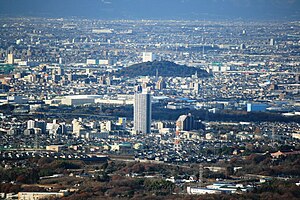Komaki
City in Chūbu, Japan From Wikipedia, the free encyclopedia
City in Chūbu, Japan From Wikipedia, the free encyclopedia
Komaki (小牧市, Komaki-shi) is a city located in Aichi Prefecture, Japan. As of 1 October 2019[update], the city had an estimated population of 148,872 in 68,174 households,[1] and a population density of 2,370 inhabitants per square kilometre (6,100/sq mi). The total area of the city was 62.81 square kilometres (24.25 sq mi). Komaki is commonly associated with the former Komaki Airport, which is located on the border between Komaki and neighboring Kasugai.
Komaki
小牧市 | |
|---|---|
  Upper:Komaki Castle Lower:Komaki Skyline | |
 Location of Komaki in Aichi Prefecture | |
| Coordinates: 35°17′27.6″N 136°54′43.6″E | |
| Country | Japan |
| Region | Chūbu (Tōkai) |
| Prefecture | Aichi |
| Government | |
| • - Mayor | Suzuo Yamashita |
| Area | |
| • Total | 62.81 km2 (24.25 sq mi) |
| Population (1 October 2019) | |
| • Total | 148,872 |
| • Density | 2,400/km2 (6,100/sq mi) |
| Time zone | UTC+9 (Japan Standard Time) |
| - Tree | Tabunoki (Machilus thunbergii) |
| - Flower | Azalea |
| Phone number | 0568-72-2101 |
| Address | 1-1 Horinouchi, Komaki-shi, Aichi-ken 485-8650 |
| Website | Official website |

Komaki is located in the middle of the Nōbi Plain, west-central Aichi Prefecture, north of the Nagoya metropolis. The city skyline is dominated by Mount Komaki, which is topped with Komaki Castle.
The city has a climate characterized by hot and humid summers, and relatively mild winters (Köppen climate classification Cfa). The average annual temperature in Komaki is 15.7 °C (60.3 °F). The average annual rainfall is 1,769 mm (69.6 in) with September as the wettest month. The temperatures are highest on average in August, at around 28.1 °C (82.6 °F), and lowest in January, at around 4.2 °C (39.6 °F).[2]
Per Japanese census data,[3] the population of Komaki has increased rapidly over the past 60 years.
| Year | Pop. | ±% |
|---|---|---|
| 1960 | 43,470 | — |
| 1970 | 79,606 | +83.1% |
| 1980 | 103,233 | +29.7% |
| 1990 | 124,441 | +20.5% |
| 2000 | 143,122 | +15.0% |
| 2010 | 147,059 | +2.8% |


Archaeological remains from the Japanese Paleolithic through Yayoi period have been found in what is now Komaki, and burial tumuli from the Kofun period are also common.
During the Sengoku period, Oda Nobunaga used Komaki Castle as his headquarters from which he launched his invasion of Mino Province and later the area surrounding Mount Komaki was the site of the Battle of Komaki and Nagakute in 1584.
It was part of the holdings of Owari Domain during the Edo period, and prospered as a post town on the route connecting Nagoya with the Nakasendō highway.
During the Meiji period establishment of the modern municipalities system, the area was organized into villages under Higashikasugai District, Aichi. Komaki was proclaimed a town on July 16, 1906, through the merger of four villages.
Komaki was raised to city status on January 1, 1955, after merging with the village of Kitasato in Nishikasugai District, Aichi.

Komaki has a mayor-council form of government with a directly elected mayor and a unicameral city legislature of 25 members. The city contributes two members to the Aichi Prefectural Assembly. In terms of national politics, the city is part of Aichi 16th district of the lower house of the Diet of Japan.


Komaki has a mixed economy, with agriculture (rice and horticulture), commence, and light manufacturing industries playing important roles.
Komaki's GDP per capita (Nominal) was ¥5,859,100 in 2014.[6][7]
Sumitomo Riko (Previously known as Tokai Gomme), a global rubber and synthetic resin products manufacturing company, whose automotive anti-vibration components hold the largest global market share, has its headquarters in the city.[8]
Due to its highway connections with the Nagoya metropolis, it is also becoming a bedroom community.
Komaki has 16 public elementary schools and nine public junior high schools operated by the city government, and three public high schools operated by the Aichi Prefectural Board of Education. There is also one private high school. The prefecture also operates one special education school for the handicapped.

The Peachliner, formally the Tōkadai Shin-kōtsū Peach Liner (桃花台新交通ピーチライナー) was a people mover which operated from 1991 until September 30, 2006, when it became the first people-mover system in Japan to cease operations.[10]

| Sex | Name | competition | League | Home | Sponsor | Since |
|---|---|---|---|---|---|---|
| Men | Nagoya Diamond Dolphins | Basketball | B.League (B1) | Dolphins Arena Park Arena Komaki |
Nagoya Diamond Dolphins (Mitsubishi Electric) |
1950 |
| Men | Nagoya Oceans | Futsal | F.League | Takeda Teva Ocean Arena Park Arena Komaki |
Teva Takeda Pharma | 2006 |
Seamless Wikipedia browsing. On steroids.
Every time you click a link to Wikipedia, Wiktionary or Wikiquote in your browser's search results, it will show the modern Wikiwand interface.
Wikiwand extension is a five stars, simple, with minimum permission required to keep your browsing private, safe and transparent.